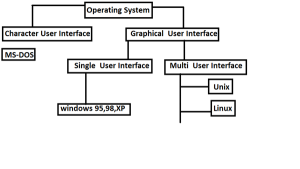Operating system
- Operating system is an elementary program for any computer. Operating system is also know as background software that provides the interface to user for interacting with compute hardware and assists computer in managing its internal resources. Operating systems are of many types. The classification of operating system is as follows:

- In the early days, Character User Interface (CUI) based operating system was used but now-a days mostly Graphical User Interface (GUI) based operating system is used. A Operating system is divided into two parts based on user interface; one is character user interface and the other is graphical user interface. In character user interface, all tasks are completed by typing command on command prompt whereas, in graphical user interface, graphical icons are used for this. DOS is an example of character user interface and windows is an example of graphical Operating system is of two types on the basis of uses; one is single user operating system and second is multiuser operating system. In single user operating system only one user can work on a computer at a time but multi user operating system more than one user can work at a time. MS-DOS is examples of a single user operating system and UNIX, Linux, Windows NT are the examples of multi user operating system.
Functions of Operating System
- As we know computer system is made combination of various types of devices. Operating system empowers these devices so that they can all functions in a better manner. It provides all types of services to the computer system. The functions carried out by it are as follows:
- Device Management: Operating system manages various types of external devices connected with the computer like – keyboard, mouse, printer, disk, memory etc. Operating system establishes relation of input/output devices with computer and sends instructions to the appropriate devices. Operating system is also known as resource manager.
- Memory Management: Operating system manages the computer system in such a way that system balance is retained during processing and the various types of resources of the system are utilized to their maximum. Operating system loads more than one program in the memory of the computer system for carrying out all these functions so that utility of CPU is maintained. Therefore, all functions related to memory in computer are performed by memory management system.
- File Management:- File is that unit in computer system where information is kept stored. Operating system stores the files prepared by various types of application programs in the secondary storage unit, manages them and reload them in memory when required. Operating system also manages information related to files through file allocation table.
- Process Management: Operating system manages processor also. If your operating system is multiuser then it provides time that is to be provided to different user. Similarly, different time is provided for different jobs in multitasking operating system.
- Security Management: Operating system provides safety to authorized users. System may have few confidential files for which we require safety. So, operating system does not grant permission to unauthorized user to access files.
Types of Operating System
1. Batch Operating System –
This type of operating system does not interact with the computer directly. There is an operator which takes similar jobs having the same requirement and group them into batches. It is the responsibility of the operator to sort jobs with similar needs.
2. Time-Sharing Operating Systems –
Each task is given some time to execute so that all the tasks work smoothly. Each user gets the time of CPU as they use a single system. These systems are also known as Multitasking Systems. The task can be from a single user or different users also. The time that each task gets to execute is called quantum.
3. Distributed Operating System –
These types of the operating system is a recent advancement in the world of computer technology and are being widely accepted all over the world and, that too, with a great pace. Various autonomous interconnected computers communicate with each other using a shared communication network. Independent systems possess their own memory unit and CPU. These are referred to as loosely coupled systemsor distributed systems
4. Network Operating System –
These systems run on a server and provide the capability to manage data, users, groups, security, applications, and other networking functions. These types of operating systems allow shared access of files, printers, security, applications, and other networking functions over a small private network.
5. Real-Time Operating System –
These types of OSs serve real-time systems. The time interval required to process and respond to inputs is very small. This time interval is called response time.
Real-time systems are used when there are time requirements that are very strict like missile systems, air traffic control systems, robots, etc.
I hope you will understand the topic operatinf system and Functions of Operating System well.
To watch Full video class click on the below link-
To watch all computer classes subscribe our youtube channel click on the link to subscribe our youtube channel.

